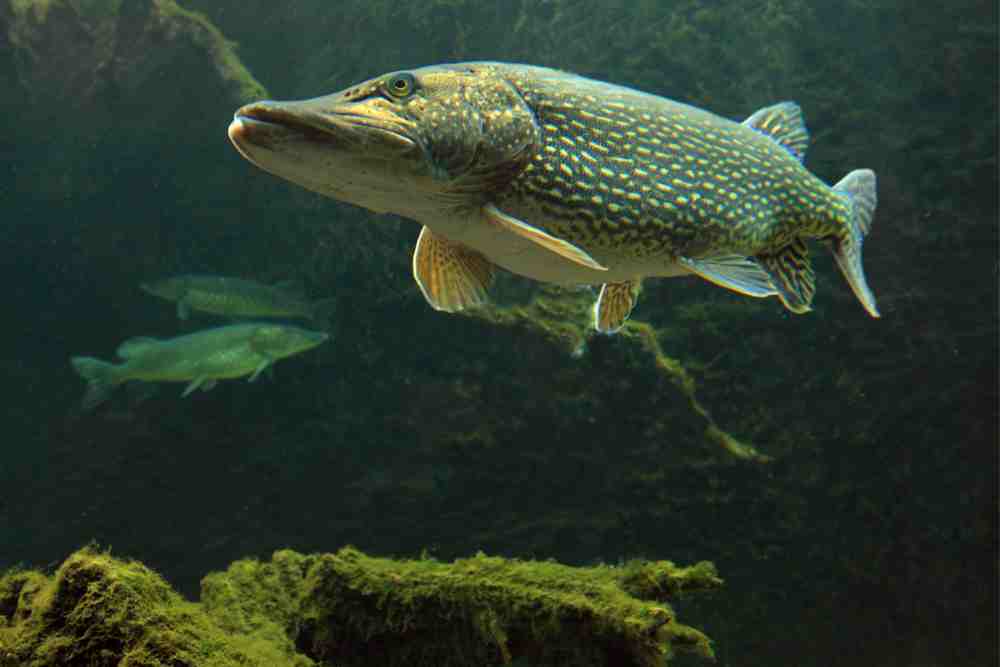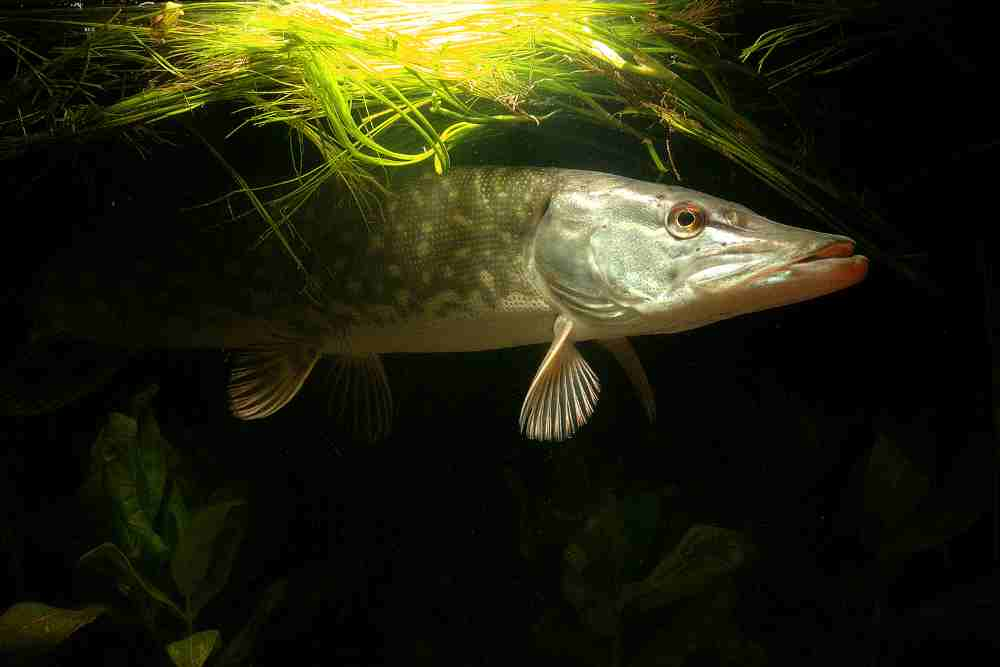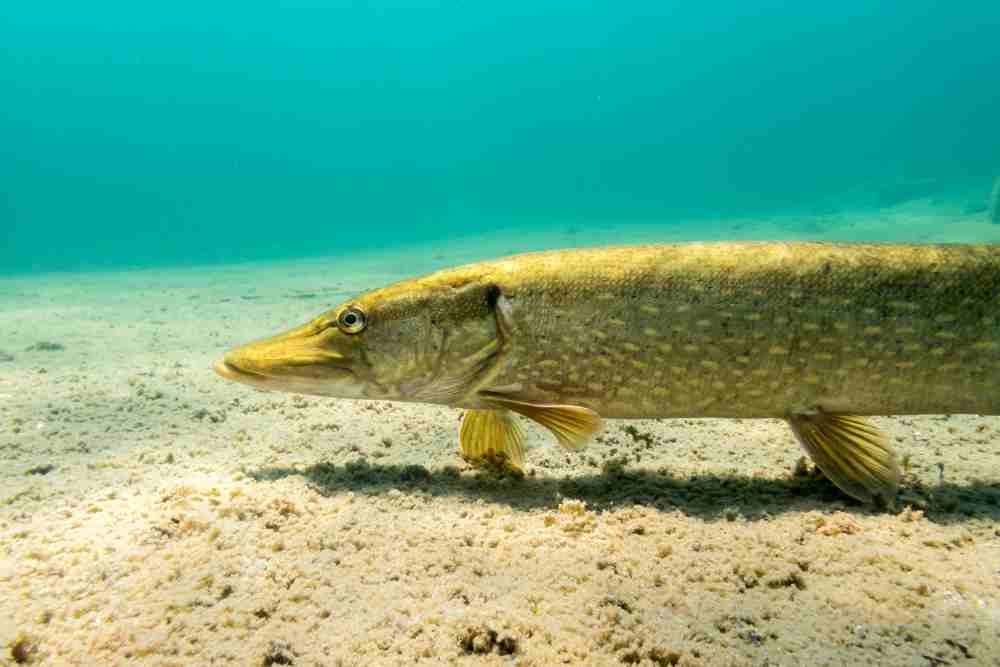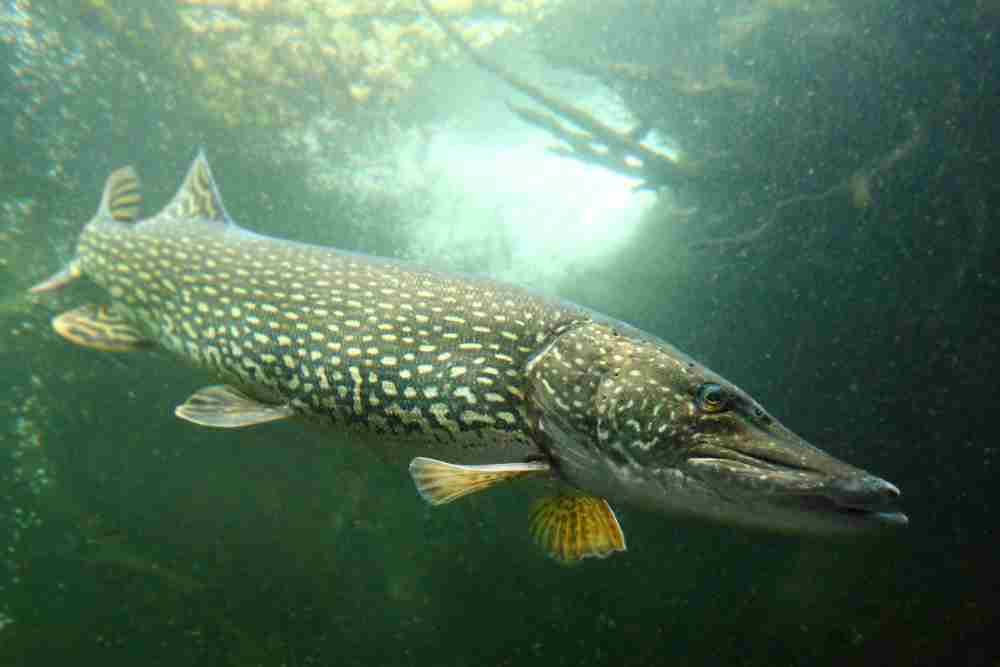The northern pike (Esox lucius) is a freshwater fish found in North America, Europe, and Asia. It is known for its long, slender body, sharp teeth, and aggressive predatory behavior.
In our blog post where we dive deep into the realm of Northern Pike fish. As avid anglers and nature enthusiasts, we have compiled a list of 10 surprising facts that will leave you amazed and intrigued by these remarkable creatures.
Read the article and explore their world and unravel the secrets behind their reputation as fierce predators and fascinating inhabitants of our lakes and rivers.

Northern Pike Fish
Northern pike, a predatory fish species inhabiting lakes, rivers, and streams across the northern hemisphere.
These crafty predators thrive in clear, shallow, slow-moving waters with dense vegetation, using their camouflage to lie in wait for unsuspecting prey.
10 Surprising Facts About Northern Pike Fish
1. Habitat and Range
Northern pike (Esox lucius) is a freshwater fish that is found in a variety of aquatic habitats throughout North America, Europe, and Asia. They prefer clear, shallow water with vegetation, such as lakes, ponds, rivers, and streams.
They are carnivorous fish species thriving in both brackish and fresh waters across the northern hemisphere.
The success of pike spawning relies heavily on finding suitable locations with fish-filled water bodies and abundant submerged vegetation. Additionally, young pike seek shelter amidst plants to protect themselves from cannibalistic tendencies.
Young pike initially feed on small invertebrates like daphnia, gradually transitioning to larger prey such as isopods, a cellus, or gamerus as they mature. As they grow older, their diet primarily consists of small fish.
2. Appearance
Northern pike has a long, slender body with greenish or brownish coloration on the back and sides. Sporting an attractive olive green hue, they showcase yellow to white shading along their bellies.
It has a large, duckbill-shaped head with sharp teeth, and a dorsal fin that is located far back on the body.
Short light bar-like spots decorate their flanks, occasionally accompanied by dark spots on their fins.
Younger pike exhibit yellow stripes along a green body, which later transform into light spots as they reach maturity.
3. Size and Weight
On average, northern pikes measure around twenty inches (51 cm) in length, but they can grow much larger. Females are generally larger and have longer lifespans compared to males.
Their coloration ranges from light green to dark olive, adorned with light, bean-shaped spots. Those residing in clear waters tend to display brighter hues.
These water wolves are often found at depths between three and fifteen feet (0.9-4.6 m) and can even inhabit waters as deep as 100 feet (30 m).
Demonstrating impressive growth potential, northern pike can attain substantial sizes, with those in Eurasia generally surpassing their North American counterparts, especially in coastal areas.
Northern pike is one of the largest freshwater fish, with the potential to reach over 4 feet in length and weigh more than 50 pounds. The average size is around 20-30 inches and 2-5 pounds.
4. Ambush Predators

They are known for their aggressive and ambush-style hunting tactics, where they wait in cover and strike at passing prey.
Northern pike is a predatory fish that feeds on a variety of prey, including fish, frogs, crayfish, and small mammals.
With a natural inclination for ambush tactics, northern pike can often be found in slow-moving streams, shallow weedy areas within lakes and reservoirs, and in cold, crystal-clear rocky waters.
5. Pond Wolf Behavior
Characterized by a single dorsal fin near the tail and mobile yellow eyes, northern pikes are dubbed “water wolves” due to their voraciousness.
Interestingly, animals tend to avoid their feces, which contains alarm pheromones, acting as a deterrent to other fish.
Despite their predatory prowess, northern pikes are not invincible and face predation from other fish, birds, and aquatic mammals, including otters. Human anglers also seek these fish for sport and sustenance.
6. Lifespan & Reproduction
During breeding, northern pikes migrate upstream to flooded areas and shallow marshland. In the spring, when the water temperature is around 40 degrees Fahrenheit (4.4 degrees Celsius), a female releases small clusters of eggs over several hours for about a week, while males follow to fertilize them.
Northern pike spawn in the spring, typically in shallow, weed-filled areas. Females can lay up to 50,000 eggs, which the males then fertilize.
After about two weeks, the eggs hatch, and neither parent provides any parental care. The eggs hatch in about 2-3 weeks, and the fry feed on plankton until they are large enough to start hunting for prey.
It takes approximately two to three years for males to reach reproductive maturity and a few additional years for females. In favorable conditions, northern pikes can live for over a decade in the wild.
Northern pike can live for up to 20 years in the wild, although most do not reach this age due to fishing pressure and other factors.
7. Behavior and Rhythm

Pike demonstrate a strong homing instinct and tend to congregate nearer to vegetation during the summer months.
Interestingly, their behavior adapts to weather conditions, prompting them to stay closer to the shoreline on sunny days and venture further out during windy periods.
Northern pikes are ambush predators, remaining motionless in an S-shape until an opportunity arises.
They possess a distinctive duck-bill shaped mouth with sharp teeth, enabling them to swiftly strike and capture other fish, frogs, crustaceans, insects, and even the occasional lost bird or mammal.
Intriguingly, they exhibit cannibalistic tendencies, as evidenced by cases where one pike has been found inside the stomach of another a true “fish-ception”.
8. Adaptive Capabilities
Northern pike is known for its ability to adapt to different environments, including both cold and warm water habitats. They can also survive in areas with low oxygen levels by gulping air at the surface.
9. Controversial Introductions
Northern pike has been introduced to some areas where they are not native, leading to controversy and concern about their impact on native fish populations.
For example, in some areas of the western United States, they have been introduced for sport fishing but have also been known to prey on endangered native species.
10. Sensory Pores
Northern pike has a unique sensory system that allows them to detect vibrations in the water and locate prey.
Notably, the lower portion of their gill cover lacks scales, while their heads and the undersides of their lower jaws feature large sensory pores, which form part of their lateral line system.
They have a specialized structure in their head called the lateral line, which can sense changes in water pressure and movement. They also have a keen sense of smell, which they use to locate food.
Understanding these sensory systems can significantly impact anglers’ strategies, allowing them to adapt presentations and fly patterns to trigger a response from the pike.
Lateral Line Sensory System: The lateral line is a crucial sensory system for pike, consisting of pores in their skin that detect slight water pressure movements. Pike use this system to identify struggling baitfish, indicating an opportunity for an easy meal.
Flies with sound-producing features like jointed streamer patterns or built-in rattles work effectively in enticing pike with their distressed fish signals. Additionally, top-water poppers that disturb the surface are particularly enticing to pike.
Vision-Based Predation: Pike heavily rely on their forward and side vision, strategically placing their eyes on their head. This dorsal-oriented vision is ideal for their ambush hunting style.
Anglers can capitalize on this by meticulously presenting flies over structures like weed edges, beaver lodges, and drop-offs where pike often lie in wait for unsuspecting prey.
Slowing down the presentation allows the pike enough time to spot the fly and initiate an attack.

Predator-Prey Discrimination: Pike employ silhouette contrast, size, and behavior to distinguish genuine prey targets visually. For fly anglers, it is essential to consider the size and silhouette of common pike food sources, such as Cisco or perch, when choosing fly patterns.
Patterns with good contrast or luminosity, resembling baitfish, further increase the chances of attracting pike. Lastly, replicating the swimming or acting style of the target species with the fly enhances its appeal to the pike.
Fly Presentation: To trigger a response from pike, anglers should ensure that their fly ticks all the boxes for predator-prey discrimination.
Casting flies of the right size, matching common prey, and using patterns with appropriate colors and contrast are crucial.
Additionally, employing the right retrieve technique at the correct depth, imitating natural prey movements, increases the likelihood of enticing pike to strike.
By incorporating these findings into their fishing strategies, anglers can enhance their success in catching northern pike and other predatory fish species.
Understanding how pike perceive and respond to their prey aids in creating effective fly presentations, increasing the excitement and satisfaction of fly fishing for these unique and remarkable creatures.
In conclusion, northern pikes showcase remarkable predatory adaptations, thriving in their preferred habitat and exhibiting intriguing behavior throughout their life cycle.
As we delve deeper into understanding these extraordinary creatures, we gain valuable insights into their ecological roles and the intricate balance of aquatic ecosystems.
For more intriguing facts about northern pikes, stay tuned to Animal Fact Files. Thank you to our patrons for their invaluable support of this channel. Don’t forget to give us a thumbs up if you learned something new today.
1 thought on “10 Surprising Facts About Northern Pike Fish”
Comments are closed.